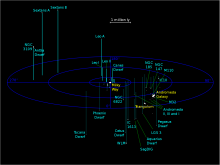Listen to today's episode of StarDate on the web the same day it airs in high-quality streaming audio without any extra ads or announcements. Choose a $8 one-month pass, or listen every day for a year for just $30.
You are here
Local Cloud
Our home galaxy, the Milky Way, is a bit like the foam on top of a bubble bath — bubbles, bubbles everywhere. Some are giant, some are tiny. And like a bubble bath, the bubbles come and go. New ones form, while others “pop.”
One of them is the Local Bubble. It spans dozens of light-years. It incorporates our solar system and many nearby stars — some of which were born as a result of the bubble’s formation. The bubble probably was inflated by several supernovas — exploding stars that swept away the gas and dust around them.
There are smaller structures within the Local Bubble. One of them is the Local Interstellar Cloud. It’s about 30 light-years across. The solar system is near its edge — just inside the cloud, or along the boundary with an adjoining cloud.
The cloud is a little bit denser than the rest of the Local Bubble. But it’s much less dense than the galaxy outside the bubble — an indication that it, too, was influenced by supernovas.
The cloud is moving away from the Scorpius-Centaurus Association — a nursery that’s given birth to thousands of stars, including many that are big, bright, and heavy. Winds from these stars may add material to the cloud, while pushing the cloud outward. Some of the stars will explode fairly soon. Their blast waves could clear out all or part of the Local Interstellar Cloud — creating new bubbles in the Milky Way.
We’ll talk about one of those future supernovas tomorrow.
Script by Damond Benningfield






